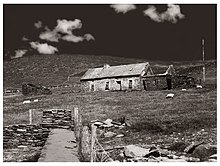This article includes a list of general references, but it lacks sufficient corresponding inline citations. (May 2021) |
52°6.37′N 10°28.15′W / 52.10617°N 10.46917°W



Slea Head (Irish: Ceann Sléibhe[1]) is a promontory on the westernmost part of the Dingle Peninsula, in southwest County Kerry, Ireland. It can be reached by the R559 road, with the nearest villages being Ballyickeen and Coumeenoole. The headland itself, together with the larger part of Mount Eagle's southern slopes, is formed from steeply dipping beds of the pebbly sandstones and conglomerates of the Slea Head Formation, dating from the Devonian period and traditionally referred to as old red sandstone.[2]
To Slea Head's northwest is Dunmore Head, the westernmost point of Ireland. Slea Head is a well-known landmark and viewpoint, with a full view of the Blasket Islands.[3] On 11 March 1982, the Spanish container ship, Ranga, was wrecked at Dunmore Head, close to Slea Head after losing power in a storm.
The Slea Head Drive edit
The Slea Head Drive is one of the Dingle Peninsula's most scenic routes. En route are several landmarks such as Ventry Beach, a pre-historic fort and beehive huts, the Dingle Famine Cottage, views of the Blasket Islands, Coumenole Beach and Gallarus Oratory. The loop road returns towards Dingle (the capital of the Kerry Gaeltacht Irish-speaking area).
References edit
- ^ "Ceann Sléibhe". Placenames Database of Ireland. Archived from the original on 26 August 2012. Retrieved 1 October 2010.
- ^ Higgs, K. and Williams, B. Geology of the Dingle Peninsula, Geological Survey of Ireland 2018
- ^ "Dingle Peninsula". Discover Ireland. Retrieved 1 October 2010.